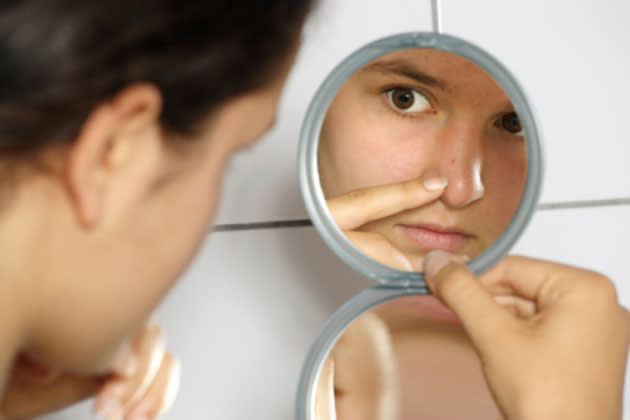When Zits Attack

We've all had red, inflamed zits that not only draw attention, but sprout at the most inopportune moments like right before a date or a big party. Instead of having a meltdown, arm yourself with these weapons and be ready for the next battle.
1. Benzoyl peroxide
What it does: This ingredient helps dry out the blemish from the inside out, while reducing thickened sebum, which blocks pores.
Forms: cream, ointment, gel or wash
How-to: Apply a small amount directly on the zit with clean hands. To reduce the frequency of breakouts, use this as a maintenance product by applying a pea-sized amount all over your face (avoid sensitive areas like the corner of your nose and around the eyes). Only a pea-sized amount is needed to ensure that you apply a thin layer.
2. Salicylic acid
What it does: This penetrates deep into the follicle, helping clear out any gunk and buildup in the pores.
Forms: Gel or wash, lotion or treated pads
How-to: Apply a thin layer on the entire face, and other acne-prone areas such as the chest and back. Only apply once a day; over-applying will not make your acne go away faster, it will just make skin dry and uncomfortable.
3. Cortisone injections
What it does: Cortisone is something our body naturally produces as a response to inflammation. While we can't plead with our body to concentrate its cortisone production to one annoying pimple, you can visit a dermatologist's clinic to ask for a cortisone shot.
The dermatologist will inject a dose of cortisone directly onto the pimple to reduce inflammation, and it will magically shrink within the next few hours. This more drastic solution is suitable for cystic zits—the kinds that are just very painful red bumps with no detectable pus. Girls usually get these on the chin right before or during their periods, when hormones go haywire.
4. Vitamins
What it does: Some vitamins are marketed for skin health, and these usually contain higher doses of vitamins A, C, E and Zinc. These four help your skin battle zits from the inside. Some topical creams have some form of vitamins A and E as an active ingredient, which are known to be effective in treating acne and promoting healing.
5. Clindamycin
What it does: Clindamycin is an antibiotic with anti-bacterial properties. Applied regularly, this helps reduce bacteria on the skin, which can dwell in your pores and form blackheads and pimples.
Form: Liquid
How-to: Moisten a cotton pad with a few drops of Clindamycin. Dab gently on the whole face while avoiding the eye area.
6. Tretinoin
What it does: Tretinoin is an acid form of Vitamin A, and this ingredient has peeling and acne treatment properties.
Forms: cream, ointment or gel
How-to: Tretinoin creams are recommended to be applied in the evening. Only a thin layer on the face is recommended, avoiding sensitive spots like eye area and nose corners. Tretinoin users should wear a sunscreen during the day as its peeling properties leave your skin sensitized, requiring protection from the sun's UVA/UVB rays.

